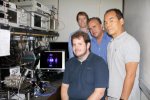- Joined
- Dec 28, 2009
- Messages
- 288
- Points
- 63
First Violet Nonpolar VCSEL Technology Created
________________________________________
Posted July 23 - ScienceDaily.com - Science News
World's First Violet Nonpolar Vertical-Cavity Laser Technology Created
Quote:
In a leap forward for laser technology, a team at University of California, Santa Barbara, has developed the first Violet nonpolar vertical-cavity surface-emitting lasers (VCSELs) based on m-plane gallium nitride semiconductors.
This recent discovery by LED pioneer Shuji Nakamura and his research team at UCSB is an achievement in VCSEL technology that opens doors for higher optical efficiency lasers at greatly reduced manufacturing costs for a variety of applications.
"We have demonstrated working, electrically-injected nonpolar m-plane nitride VCSELs lasing at room temperature, and have shown that such devices are naturally polarization-locked along the crystallographic a-direction of the wurtzite crystal. This is in contrast to the majority of VCSELs, which are typically randomly polarized . . .
Quote:
Shuji Nakamura and his research group at UCSB demonstrate the first nonpolar m-plane VCSEL based on gallium nitride
Quote:
"This is the first report of a nonpolar VCSEL, which we believe to be one of the biggest breakthroughs in the field of laser diode technology," explained Nakamura, a professor of Materials at UCSB . "The nonpolar VCSEL has a lot of advantages in comparison with conventional c-plane devices. One major advantage is that the light polarization is locked to one direction.
Quote:
VCSELs offer advantages over conventional edge-emitting laser technology for some applications. On-wafer testing of VCSEL arrays during the manufacturing process, for example, can save costs compared to edge-emitting lasers that require additional steps before they can be tested. VCSELs exhibit low threshold currents, circular and low divergence output beams, and are easily integrated into two-dimensional arrays.
The nonpolar VCSEL platform also provides high optical gain, which helps to increase optical efficiency of devices.
Attached Thumbnails
________________________________________
Posted July 23 - ScienceDaily.com - Science News
World's First Violet Nonpolar Vertical-Cavity Laser Technology Created
Quote:
In a leap forward for laser technology, a team at University of California, Santa Barbara, has developed the first Violet nonpolar vertical-cavity surface-emitting lasers (VCSELs) based on m-plane gallium nitride semiconductors.
This recent discovery by LED pioneer Shuji Nakamura and his research team at UCSB is an achievement in VCSEL technology that opens doors for higher optical efficiency lasers at greatly reduced manufacturing costs for a variety of applications.
"We have demonstrated working, electrically-injected nonpolar m-plane nitride VCSELs lasing at room temperature, and have shown that such devices are naturally polarization-locked along the crystallographic a-direction of the wurtzite crystal. This is in contrast to the majority of VCSELs, which are typically randomly polarized . . .
Quote:
Shuji Nakamura and his research group at UCSB demonstrate the first nonpolar m-plane VCSEL based on gallium nitride
Quote:
"This is the first report of a nonpolar VCSEL, which we believe to be one of the biggest breakthroughs in the field of laser diode technology," explained Nakamura, a professor of Materials at UCSB . "The nonpolar VCSEL has a lot of advantages in comparison with conventional c-plane devices. One major advantage is that the light polarization is locked to one direction.
Quote:
VCSELs offer advantages over conventional edge-emitting laser technology for some applications. On-wafer testing of VCSEL arrays during the manufacturing process, for example, can save costs compared to edge-emitting lasers that require additional steps before they can be tested. VCSELs exhibit low threshold currents, circular and low divergence output beams, and are easily integrated into two-dimensional arrays.
The nonpolar VCSEL platform also provides high optical gain, which helps to increase optical efficiency of devices.
Attached Thumbnails
Attachments
Last edited:




